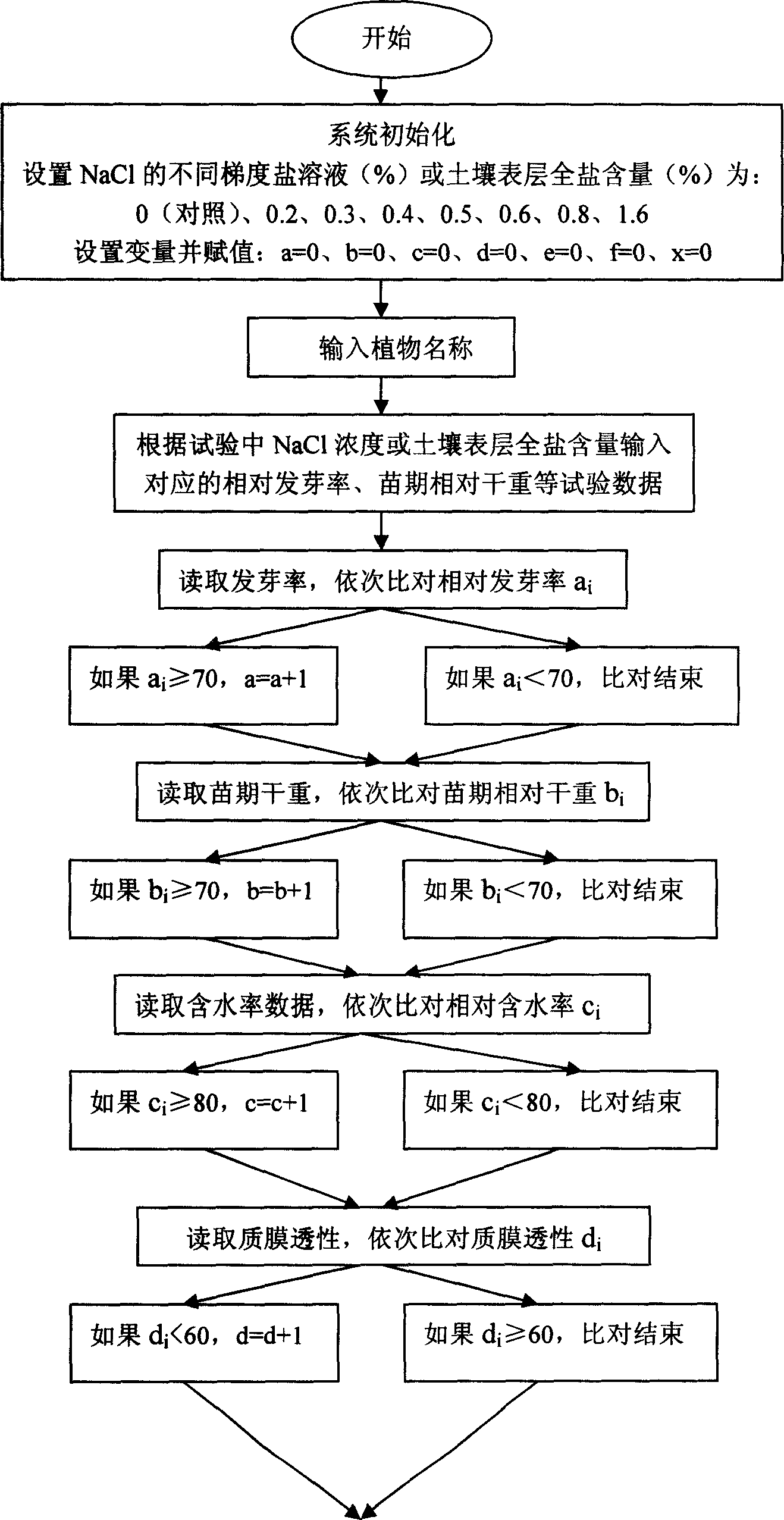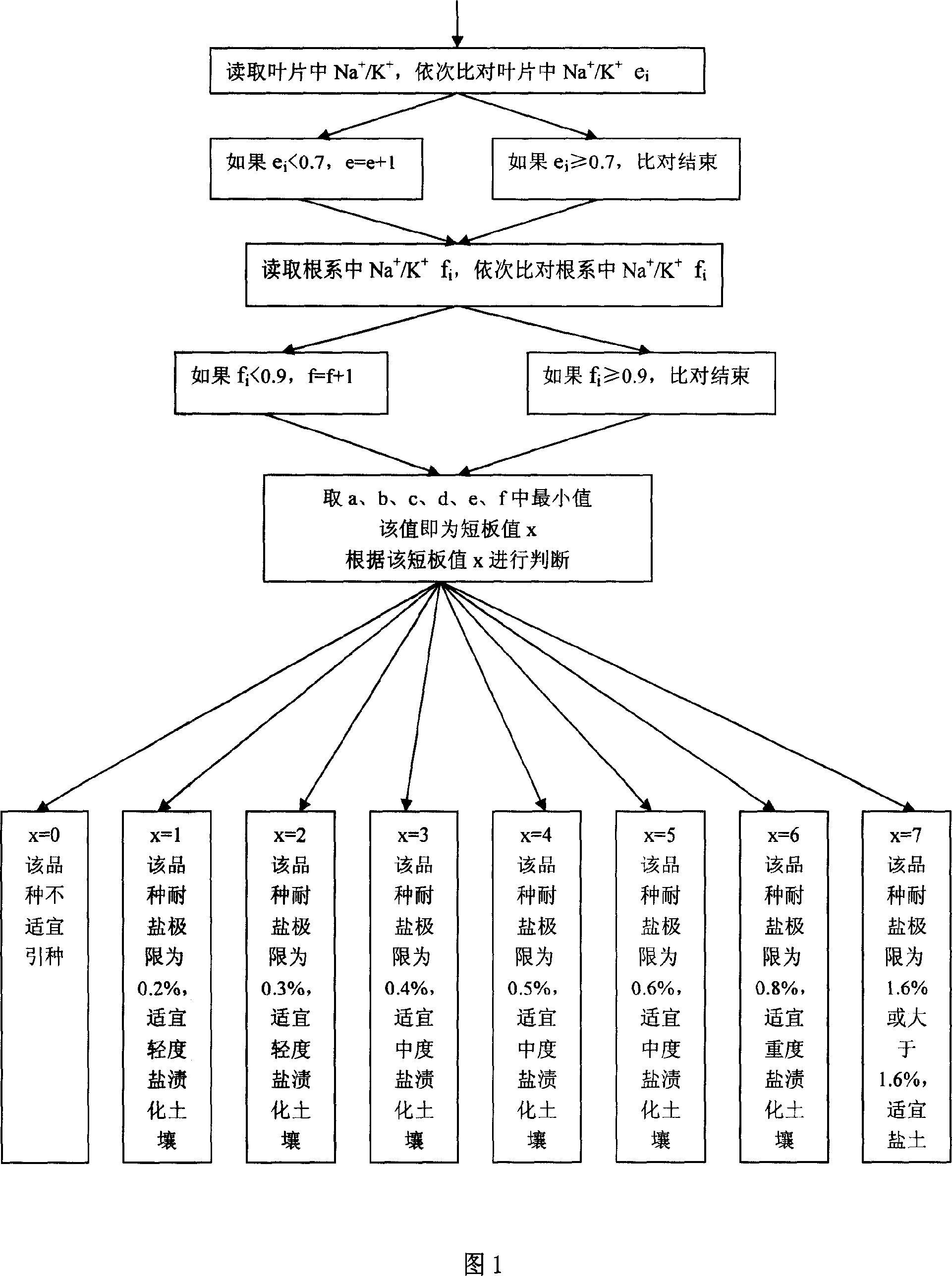Computer estimation method for salt tolerance of non-halophyte herbaceous plant
A herb and computer technology, which is applied in the field of computer evaluation, can solve the problems of difficulty in evaluating the salt tolerance of soil salinity plants, difficulty in human control, and no computer evaluation method for salt tolerance identification of non-halophyte herbs.
- Summary
- Abstract
- Description
- Claims
- Application Information
AI Technical Summary
Problems solved by technology
Method used
Image
Examples
Embodiment 1
[0048] Example 1: Identification of Salt Tolerance of Martin's Reed Fescue (Festuca Arundinacea)
[0049] 1. Materials and methods
[0050] Introduced species: Martin's reed fescue (Festuca Arundinacea)
[0051] Test method: According to the introduction of the characteristics of the introduced martin reed fescue, use the highest salt content of 0.8% to conduct greenhouse cultivation and pot experiments, and conduct necessary laboratory analysis.
[0052] (1) Seed germination rate greenhouse cultivation test: use chemically pure NaCl to make 0 (without adding NaCl), 0.2%, 0.3%, 0.4%, 0.5%, 0.6% and 0.8% 7 different gradient salt solutions, in diameter Add about 5 grams of washed sawdust to a 120mm petri dish, cover with a layer of filter paper, add about 40ml of prepared saline solution to each petri dish, and then put 50 seeds in an incubator. Under variable temperature conditions, 9 hours at 18 degrees and 15 hours at 28 degrees are alternately cultivated. During the cult...
Embodiment 2
[0062] Example 2: Identification of Salt Tolerance of Agropyron australis
[0063] 1. Materials and methods
[0064] Introduced species: Orbita icegrass
[0065] Test method: (1) Seed germination rate test: use chemically pure NaCl to prepare 8 different gradient salts of 0 (without adding NaCl), 0.2%, 0.3%, 0.4%, 0.5%, 0.6%, 0.8% and 1.6% Solution, add about 5 grams of washed sawdust to a petri dish with a diameter of 120mm, cover with a layer of filter paper, add about 40ml of prepared salt solution to each petri dish, then put 50 seeds, and place in a warm In the box, they were cultivated alternately at 18 degrees for 9 hours and 28 degrees for 15 hours under variable temperature conditions. During the cultivation period, the evaporated water should be replenished in time, and the salt concentration of each treatment should be kept constant based on the level of the liquid surface and the sawdust surface. Repeat 3 times for each different gradient salt solution. After 1...
Embodiment 3
[0075] Embodiment 3: Salt tolerance identification of Holdfast weed
[0076] 1. Materials and methods
[0077] Introduced species: Holdfast weed
[0078] Test method: According to the introduction of the variety characteristics of the introduced Holdfast weed, the highest salt content of 0.6% is used to conduct the seed germination rate test and pot test, and carry out necessary laboratory analysis.
[0079] (1) Seed germination rate test: use chemically pure NaCl to prepare 6 salt solutions with different gradients of 0 (without adding NaCl), 0.2%, 0.3%, 0.4%, 0.5% and 0.6%, in a petri dish with a diameter of 120mm Add about 5 grams of washed sawdust to the medium, cover with a layer of filter paper, add about 40ml of the prepared salt solution to each petri dish, and then put 50 seeds in the incubator, under variable temperature conditions 18 degrees 9 hours and 15 hours at 28 degrees alternate cultivation. During the cultivation period, the evaporated water should be rep...
PUM
 Login to View More
Login to View More Abstract
Description
Claims
Application Information
 Login to View More
Login to View More - R&D
- Intellectual Property
- Life Sciences
- Materials
- Tech Scout
- Unparalleled Data Quality
- Higher Quality Content
- 60% Fewer Hallucinations
Browse by: Latest US Patents, China's latest patents, Technical Efficacy Thesaurus, Application Domain, Technology Topic, Popular Technical Reports.
© 2025 PatSnap. All rights reserved.Legal|Privacy policy|Modern Slavery Act Transparency Statement|Sitemap|About US| Contact US: help@patsnap.com


